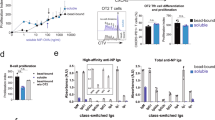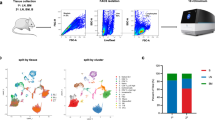Abstract
Two groups of human lymphocytes are distinguished on the basis of immune effector functions, membrane markers and in vitro mitogen reactivity. Thymus-derived (T) lymphocytes mediate cellular immunity either directly or by secreting pharmacologically active lymphokines1, and are implicated in facilitating antibody responses2. In contrast, bone marrow-derived (B) lymphocytes are thought to produce only antibodies. Studies in the guinea pig, however, indicate that, appropriately stimulated, B cells can produce macrophage migration inhibitory factor (MIF)3. We have now found that the erythrocyte–antibody (19S)–complement (EAC) rosetting method, used to obtain pure human peripheral blood B cells, activates these B cells to produce mononuclear cell chemotactic (CTX) and mitogenic (MF) lymphokines. Furthermore, we have investigated the mechanism of B cell activation by EAC and the effects of mitogenic lymphokines on human T and B lymphocytes.
This is a preview of subscription content, access via your institution
Access options
Subscribe to this journal
Receive 51 print issues and online access
$199.00 per year
only $3.90 per issue
Buy this article
- Purchase on Springer Link
- Instant access to full article PDF
Prices may be subject to local taxes which are calculated during checkout
Similar content being viewed by others
References
Good, R. A., Cell. Immun., 3, 1 (1972).
Anderson, J., Möller, G., and Sjöberg, O., Eur. J. Immun., 2, 99 (1972).
Yoshida, T., Sonozaki, H., and Cohen, S., J. exp. Med., 138, 784 (1972).
Greaves, M. F., and Barminger, S., Nature new Biol., 235, 67 (1972).
Bianco, C., Patrick, R., and Nussenzweig, V. J., J. exp. Med., 132, 702 (1970).
Altman, L. C., Snyderman, R., Oppenheim, J. J., and Mergenhagen, S. E., J. Immun., 110, 801 (1973).
Chaparas, S. D., Thor, D. E., Godfrey, H. D., Baer, H., and Hedrick, S. T., Science, 170, 637 (1970).
Rocklin, R. E., and Ratcliffe, H. E., Fedn Proc., 31, 753 (1972).
Mackler, B. F., Wolstencroft, R. A., and Dumonde, D. C., Nature new Biol., 239, 139 (1972).
Dukor, P., and Hartmann, K. U., Cell Immun., 7, 349 (1973).
Phillips, B., and Roitt, I. M., Nature new Biol., 241, 254 (1973).
Chess, L., MacDermott, R. P., and Schlossman, S. F., Fedn Proc. Abstr. (1974).
Mackler, B. F., Altman, L. C., Wahl, S., Rosenstreich, P. L., Oppenheim, J. J., and Mergenhagen, S. E., J. dent. Res., 53, 225 (1974).
Geha, R. S., Rosen, F. S., and Merler, E., Nature, 248, 426 (1974).
Author information
Authors and Affiliations
Rights and permissions
About this article
Cite this article
MACKLER, B., ALTMAN, L., ROSENSTREICH, D. et al. Induction of lymphokine production by EAC and of blastogenesis by soluble mitogens during human B-cell activation. Nature 249, 834–837 (1974). https://doi.org/10.1038/249834a0
Received:
Revised:
Issue Date:
DOI: https://doi.org/10.1038/249834a0
This article is cited by
-
Cellular immunity in children with coeliac disease
European Journal of Pediatrics (1982)
Comments
By submitting a comment you agree to abide by our Terms and Community Guidelines. If you find something abusive or that does not comply with our terms or guidelines please flag it as inappropriate.



